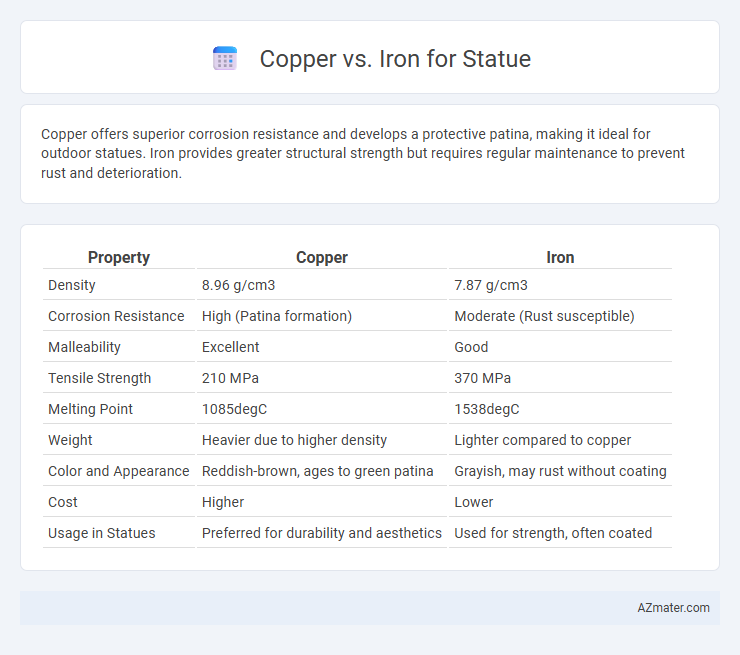Copper offers superior corrosion resistance and develops a protective patina, making it ideal for outdoor statues. Iron provides greater structural strength but requires regular maintenance to prevent rust and deterioration.
Table of Comparison
| Property | Copper | Iron |
|---|---|---|
| Density | 8.96 g/cm3 | 7.87 g/cm3 |
| Corrosion Resistance | High (Patina formation) | Moderate (Rust susceptible) |
| Malleability | Excellent | Good |
| Tensile Strength | 210 MPa | 370 MPa |
| Melting Point | 1085degC | 1538degC |
| Weight | Heavier due to higher density | Lighter compared to copper |
| Color and Appearance | Reddish-brown, ages to green patina | Grayish, may rust without coating |
| Cost | Higher | Lower |
| Usage in Statues | Preferred for durability and aesthetics | Used for strength, often coated |
Introduction: Comparing Copper and Iron for Statues
Copper offers superior corrosion resistance and develops a protective patina over time, making it ideal for outdoor statues. Iron provides greater structural strength and affordability but requires protective coatings to prevent rusting in outdoor environments. Both metals present distinctive aesthetic qualities and maintenance needs influencing their suitability for sculpture projects.
Historical Use of Copper and Iron in Sculptures
Copper has been historically favored for sculptures due to its malleability and resistance to corrosion, with notable examples such as the ancient Egyptian statues and the iconic Statue of Liberty's copper exterior. Iron, while less common in early sculpture owing to its susceptibility to rust, gained prominence during the Industrial Revolution, enabling the creation of durable and large-scale public monuments. The contrasting properties of copper's longevity and iron's strength have influenced their respective applications in art and architectural statuary throughout history.
Physical Properties: Copper vs Iron
Copper exhibits excellent malleability and corrosion resistance, making it ideal for detailed and long-lasting statues, while iron offers superior tensile strength but is prone to rust without protective coatings. Copper's density of 8.96 g/cm3 provides sturdiness with moderate weight, whereas iron, with a density of 7.87 g/cm3, is lighter but can oxidize quickly in outdoor environments. Thermal conductivity in copper is significantly higher than iron, influencing the weathering and preservation of statues over time.
Durability and Longevity of Copper and Iron Statues
Copper statues exhibit superior corrosion resistance due to their natural patina layer that protects against environmental elements, extending their durability significantly over time. Iron statues are more prone to rust and structural deterioration when exposed to moisture and atmospheric conditions, often requiring protective coatings to maintain longevity. Consequently, copper's natural oxidation process enhances the lifespan of statues, making it a preferred material for outdoor monuments with long-term exposure.
Aesthetic Appeal: Surface Finish and Patina
Copper statues develop a rich, greenish patina over time due to oxidation, enhancing their aesthetic appeal with a historic and natural look, while maintaining a smooth surface finish that emphasizes intricate details. Iron statues, although initially offering a solid and robust appearance, tend to develop rust that can degrade the surface finish and diminish visual appeal unless properly treated or coated. The unique aging process of copper contributes to its desirability for art and monuments focused on long-term beauty, whereas iron requires ongoing maintenance to preserve its aesthetic qualities.
Resistance to Corrosion and Weathering
Copper exhibits superior resistance to corrosion and weathering compared to iron, forming a protective green patina that shields it from environmental damage. Iron statues are more prone to rust and deterioration when exposed to moisture and pollutants, requiring frequent maintenance to prevent decay. The natural oxidation process enables copper to maintain structural integrity and aesthetic appeal over prolonged outdoor exposure.
Workability and Sculpting Flexibility
Copper offers excellent workability and sculpting flexibility due to its malleability and ductility, allowing artists to create intricate details and smooth curves with ease. Iron, while strong and durable, is harder and less malleable, which limits fine sculpting and requires more force and specialized tools. Copper's ability to be easily heated and shaped without cracking makes it a preferred choice for statues that demand detailed craftsmanship.
Cost Comparison: Copper vs Iron Statues
Copper statues generally have a higher initial cost compared to iron statues due to the price of raw copper and its specialized casting processes. Iron statues are typically more affordable because iron is more abundant and easier to mold, but they may require additional treatments to prevent rust and corrosion over time. When evaluating long-term expenses, copper statues offer better durability and lower maintenance costs, potentially offsetting the higher upfront investment.
Environmental Impact and Sustainability
Copper statues exhibit superior environmental sustainability due to their high recyclability and lower energy requirements during extraction compared to iron. Iron production generates significantly more carbon emissions and relies heavily on mining practices that disrupt ecosystems and deplete finite resources. The corrosion resistance of copper enhances the longevity of statues, reducing the frequency of replacements and minimizing environmental footprints over time.
Conclusion: Choosing Between Copper and Iron for Statues
Copper offers superior corrosion resistance and develops an attractive green patina over time, making it ideal for outdoor statues requiring longevity and aesthetic appeal. Iron provides greater structural strength but is prone to rust without protective coatings, making it better suited for indoor sculptures or environments with controlled exposure. Choosing between copper and iron depends on the statue's intended environment, desired durability, and maintenance considerations.

Infographic: Copper vs Iron for Statue
 azmater.com
azmater.com